Astrolabe
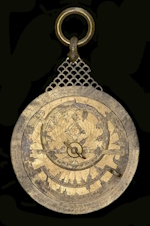 This device is thought to have been first developed by the ancient Greeks, the term astrolabe meaning ‘star taker.’ It is a primitive inclinometer that calculates the altitude of the sun and stars to determine latitude. An astrolabe can be used for both astronomy and navigation at sea. Elaborate astrolabes can have etchings of how the sky looks at any given time or season. Sailors used this device by lining it up with the sun or a specific star, such as the North Star, in relation to the horizon in order to measure latitude vertically. This helped sailors to determine their location while at sea. Astrolabes came in a variety of shapes, such as a sphere or as flat plates and disks, and were made of metal, usually brass or iron, the former ensuring longevity at sea. A disadvantage was that astrolabes were cumbersome and could be difficult to use on the rolling deck of a ship.
This device is thought to have been first developed by the ancient Greeks, the term astrolabe meaning ‘star taker.’ It is a primitive inclinometer that calculates the altitude of the sun and stars to determine latitude. An astrolabe can be used for both astronomy and navigation at sea. Elaborate astrolabes can have etchings of how the sky looks at any given time or season. Sailors used this device by lining it up with the sun or a specific star, such as the North Star, in relation to the horizon in order to measure latitude vertically. This helped sailors to determine their location while at sea. Astrolabes came in a variety of shapes, such as a sphere or as flat plates and disks, and were made of metal, usually brass or iron, the former ensuring longevity at sea. A disadvantage was that astrolabes were cumbersome and could be difficult to use on the rolling deck of a ship.
Backstaff
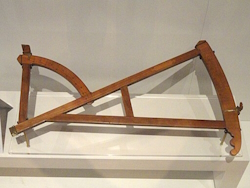 Also known as a back quadrant or Davis staff, this early navigational instrument was used for measuring the altitude of the sun. It had a significant advantage over the earlier cross-staff: it allowed the user to measure the altitude of the sun without looking directly at it. Instead, the navigator used the shadow cast by the sun, standing with their back to it and marking the angle of the sun by measuring its shadow with the help of three vanes – the horizon vane, sight vane, and shadow vane. The backstaff’s design also made it more stable and less prone to errors caused by the movement of the ship. It was invented by John Davis in 1594, becoming a popular device for measuring latitude throughout the 17th and 18th centuries.
Also known as a back quadrant or Davis staff, this early navigational instrument was used for measuring the altitude of the sun. It had a significant advantage over the earlier cross-staff: it allowed the user to measure the altitude of the sun without looking directly at it. Instead, the navigator used the shadow cast by the sun, standing with their back to it and marking the angle of the sun by measuring its shadow with the help of three vanes – the horizon vane, sight vane, and shadow vane. The backstaff’s design also made it more stable and less prone to errors caused by the movement of the ship. It was invented by John Davis in 1594, becoming a popular device for measuring latitude throughout the 17th and 18th centuries.
Compass
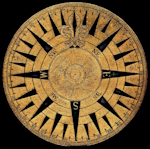 One of the oldest nautical tools, this device comprised of a magnetic lodestone which made use of the Earth’s magnetic field. It is thought to have originated in China around 200 BC, arriving in Europe sometime in the 12th century. The earliest European compasses consisted of a magnetised needle floating in a bowl of water, but by the 14th century they had evolved into a more recognisable form with a magnetised needle mounted on a pivot over a background displaying the cardinal directions (north, south, east, west), always pointing north. It was usually mounted inside a special wooden case called the binnacle. Before its widespread use in Europe, sailors had to rely on using the stars to determine their direction.
One of the oldest nautical tools, this device comprised of a magnetic lodestone which made use of the Earth’s magnetic field. It is thought to have originated in China around 200 BC, arriving in Europe sometime in the 12th century. The earliest European compasses consisted of a magnetised needle floating in a bowl of water, but by the 14th century they had evolved into a more recognisable form with a magnetised needle mounted on a pivot over a background displaying the cardinal directions (north, south, east, west), always pointing north. It was usually mounted inside a special wooden case called the binnacle. Before its widespread use in Europe, sailors had to rely on using the stars to determine their direction.
Chronometer
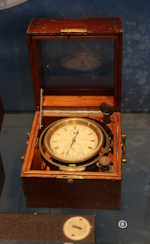 This was a relatively accurate timepiece which was used to establish longitude and/or give an exact measurement of the passage of time. First developed in 1736, John Harrison’s groundbreaking invention allowed sailors to calculate longitude more accurately by the end of the century. Sailors could determine their position by keeping precise time at a known location. Although the first chronometer was complex, it gave later developers a basis to work with.
This was a relatively accurate timepiece which was used to establish longitude and/or give an exact measurement of the passage of time. First developed in 1736, John Harrison’s groundbreaking invention allowed sailors to calculate longitude more accurately by the end of the century. Sailors could determine their position by keeping precise time at a known location. Although the first chronometer was complex, it gave later developers a basis to work with.
Cross staff
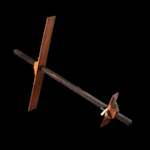 Also known as a Jacob’s staff, fore-staff, or ballastella, this device was the more basic predecessor of the backstaff used to determine latitude. The user had to face the sun, or the North Star, to measure its angle to the horizon by sliding a cross piece up and down the main staff marked with measurements. It’s use was prevalent from the 14th until the end of the 16th century, when it was replaced by the backstaff.
Also known as a Jacob’s staff, fore-staff, or ballastella, this device was the more basic predecessor of the backstaff used to determine latitude. The user had to face the sun, or the North Star, to measure its angle to the horizon by sliding a cross piece up and down the main staff marked with measurements. It’s use was prevalent from the 14th until the end of the 16th century, when it was replaced by the backstaff.
Nocturnal
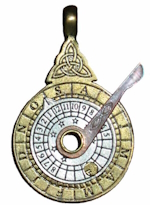 This device uses a set of dials with pointers showing months, hours, and the location of stars, and is important when calculating tides. It was used to determine the local time based on the position of stars such as Polaris, Ursa Minor, and Ursa Major in the night sky to ascertain the time of night using the location of these stars. It is thought to have been first developed in the 12th century.
This device uses a set of dials with pointers showing months, hours, and the location of stars, and is important when calculating tides. It was used to determine the local time based on the position of stars such as Polaris, Ursa Minor, and Ursa Major in the night sky to ascertain the time of night using the location of these stars. It is thought to have been first developed in the 12th century.
Octant
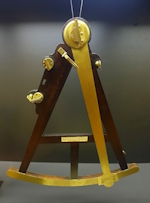 This instrument was developed in the early 18th century and was a precursor to the sextant. It measured angles up to 45 degrees, making it ideal for determining the altitude of celestial bodies. The octant was more portable and accurate than earlier instruments like the astrolabe, which quickly made it popular among mariners until it was replaced by the sextant in the mid-eighteen century.
This instrument was developed in the early 18th century and was a precursor to the sextant. It measured angles up to 45 degrees, making it ideal for determining the altitude of celestial bodies. The octant was more portable and accurate than earlier instruments like the astrolabe, which quickly made it popular among mariners until it was replaced by the sextant in the mid-eighteen century.
Pelorus
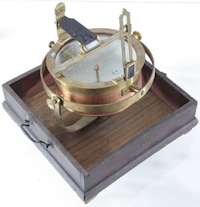 This navigational tool looks similar to a compass, but it doesn’t actually show directions. It is a simple, effective tool which is used to determine the bearing of a landmark or celestial body relative to the ship’s heading. It doesn’t have a magnetic needle like a compass, but instead remains at the 000 degrees to align with a lubber line, a fixed line on the binnacle of a compass which points towards the front of the ship. It was used by sailors to determine if they were going in a forward direction and was particularly useful for coastal navigation, where sailors could use landmarks to stay on course. It is thought that the pelorus came into use before the compass, in particular by the Polynesians. Nowadays, this tool is used on modern boats to measure the distance between one boat and another.
This navigational tool looks similar to a compass, but it doesn’t actually show directions. It is a simple, effective tool which is used to determine the bearing of a landmark or celestial body relative to the ship’s heading. It doesn’t have a magnetic needle like a compass, but instead remains at the 000 degrees to align with a lubber line, a fixed line on the binnacle of a compass which points towards the front of the ship. It was used by sailors to determine if they were going in a forward direction and was particularly useful for coastal navigation, where sailors could use landmarks to stay on course. It is thought that the pelorus came into use before the compass, in particular by the Polynesians. Nowadays, this tool is used on modern boats to measure the distance between one boat and another.
Quadrant
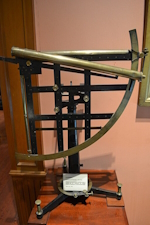 This device, which was made of wood or brass, measures at 90o angles how high the sun or North Star is above the horizon in order to determine latitude. In order to use it, one has to sight in on the right side of the edge of the angle. A weight tied to a rope (plumb bob) crosses the scale along the bottom to give the angular height of the celestial body. It was first developed in about 1460 for marine navigation. It was simpler and cheaper to produce than the astrolabe but was far less accurate. Although widely used it was eventually superseded by the more precise octant in the early 18th century, which was in turn replaced by the sextant in the middle of the same century.
This device, which was made of wood or brass, measures at 90o angles how high the sun or North Star is above the horizon in order to determine latitude. In order to use it, one has to sight in on the right side of the edge of the angle. A weight tied to a rope (plumb bob) crosses the scale along the bottom to give the angular height of the celestial body. It was first developed in about 1460 for marine navigation. It was simpler and cheaper to produce than the astrolabe but was far less accurate. Although widely used it was eventually superseded by the more precise octant in the early 18th century, which was in turn replaced by the sextant in the middle of the same century.
Reflecting circle
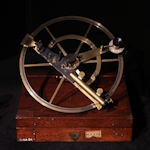 Also known as a circle sextant, Borda circle, reflecting circle, or circumferator, this was a circular instrument which used mirrors to measure the angular distance between two diverging objects at once. It usually consisted of a polished brass frame with a wooden handle. It was used to measure angles greater than 180 degrees. At sea it was mostly used for finding longitude. This device was invented by the German astronomer Tobias Mayer in 1752, its use being more widespread in the French than in the British navy.
Also known as a circle sextant, Borda circle, reflecting circle, or circumferator, this was a circular instrument which used mirrors to measure the angular distance between two diverging objects at once. It usually consisted of a polished brass frame with a wooden handle. It was used to measure angles greater than 180 degrees. At sea it was mostly used for finding longitude. This device was invented by the German astronomer Tobias Mayer in 1752, its use being more widespread in the French than in the British navy.
Sand glass
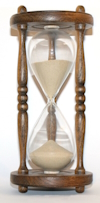 This item, which is also known as as hourglass or sand clock, has been used since antiquity to keep track of time. It was essential for determining both speed and distance travelled at sea. Sailors typically used 30-minute or one-hour sand glasses to track watch duties and measure the passage of time. Combined with a chip log, which was a device for measuring the ship’s speed, the sand glass allowed mariners to calculate how far they had travelled in a set amount of time, a remarkably effective method in an era without precise timekeeping. However, errors did creep in and misjudging the speed can throw a vessel off course by many miles.
This item, which is also known as as hourglass or sand clock, has been used since antiquity to keep track of time. It was essential for determining both speed and distance travelled at sea. Sailors typically used 30-minute or one-hour sand glasses to track watch duties and measure the passage of time. Combined with a chip log, which was a device for measuring the ship’s speed, the sand glass allowed mariners to calculate how far they had travelled in a set amount of time, a remarkably effective method in an era without precise timekeeping. However, errors did creep in and misjudging the speed can throw a vessel off course by many miles.
Sextant
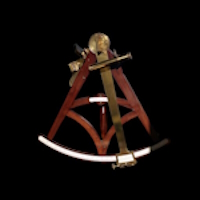 Viewed as a breakthrough in navigation, this instrument was used for measuring the angle between a celestial object and the horizon in order to determine latitude and longitude. It first appeared in the mid 18th century, so would not have been available to the pirates of the Golden Age. The sextant consists of a scale that is utilized to measure the distance between visible objects both day and night, typically a celestial body and the horizon, measuring the angle between them. In order to do so, this navigation tool relies on a 60-degree arch that reflects off two embedded mirrors for a measuring scope of 120 degrees. By adjusting the arm of the sextant, the two images are brought into alignment, allowing them to measure the angle with great precision. The sextant superseded all of its navigational predecessors due to its accuracy, and is sometimes still used to this day as a backup. With the introduction of the sextant, sailors could not only find their latitude but, they could also calculate longitude with the help of a marine chronometer.
Viewed as a breakthrough in navigation, this instrument was used for measuring the angle between a celestial object and the horizon in order to determine latitude and longitude. It first appeared in the mid 18th century, so would not have been available to the pirates of the Golden Age. The sextant consists of a scale that is utilized to measure the distance between visible objects both day and night, typically a celestial body and the horizon, measuring the angle between them. In order to do so, this navigation tool relies on a 60-degree arch that reflects off two embedded mirrors for a measuring scope of 120 degrees. By adjusting the arm of the sextant, the two images are brought into alignment, allowing them to measure the angle with great precision. The sextant superseded all of its navigational predecessors due to its accuracy, and is sometimes still used to this day as a backup. With the introduction of the sextant, sailors could not only find their latitude but, they could also calculate longitude with the help of a marine chronometer.
Telescope
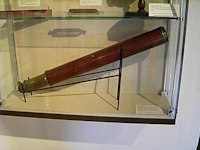 This ubiquitous instrument was also called a spyglass or “bring ’em near”. It is an optical tool that uses lenses or mirrors to make distant objects appear closer. They were first produced in large quantities at the end of the 18th century. Its use could help identify navigational hazards at longer distances, especially useful for identifying vessels in the age of piracy and times of war. It also made the use of communications by signal flags more practical. Early telescopes consisted of barrels constructed of leather, vellum, or wood with the lenses held in place by brass fittings, but as technology advanced barrels of brass became more common.
This ubiquitous instrument was also called a spyglass or “bring ’em near”. It is an optical tool that uses lenses or mirrors to make distant objects appear closer. They were first produced in large quantities at the end of the 18th century. Its use could help identify navigational hazards at longer distances, especially useful for identifying vessels in the age of piracy and times of war. It also made the use of communications by signal flags more practical. Early telescopes consisted of barrels constructed of leather, vellum, or wood with the lenses held in place by brass fittings, but as technology advanced barrels of brass became more common.
Traverse board
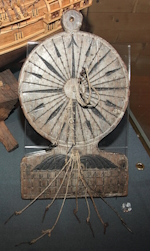 This tool was a recording device used by sailors to keep track of the ship’s speed and direction over the course of a watch, which lasted usually four hours. The board had a series of pegs and holes that represented different directions and speeds. As the ship’s heading and speed changed, the officer of the watch would move the pegs to reflect the changes. At the end of each watch, the navigator collected the information and calculated the vessel’s progress and projected track.
This tool was a recording device used by sailors to keep track of the ship’s speed and direction over the course of a watch, which lasted usually four hours. The board had a series of pegs and holes that represented different directions and speeds. As the ship’s heading and speed changed, the officer of the watch would move the pegs to reflect the changes. At the end of each watch, the navigator collected the information and calculated the vessel’s progress and projected track.
